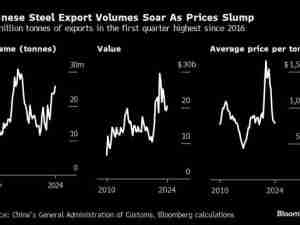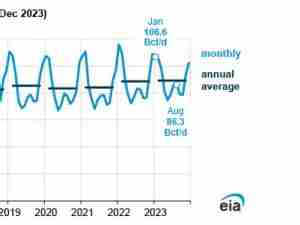China’s Clear-Sky Push Wins Believers After Gas-Buying Binge
By: | May 25 2017 at 01:40 AM | International Trade
With factories and power plants across China burning half the world’s coal, the government’s latest targets for using more natural gas to ease the country’s worsening air pollution seemed too ambitious.
Though gas remains a small and expensive component in China’s fuel mix, demand is rising faster than expected for domestic and imported supplies. In April, consumption was 22 percent higher than the same month in 2016, and the total for the first four months of the year is up more than 12 percent, data from the National Development and Reform Commission show.
The results are encouraging analysts to upgrade their demand forecasts and may signal the government is on track to reach its goal of getting as much as 10 percent of its energy from gas by 2020. It’s also bolstering the outlook for hundreds of billions of dollars in possible investments by companies as far away as Russia, Australia and the U.S. to build gas pipelines and export infrastructure to feed the growing Chinese market.
“China’s targets are looking more and more achievable,” said Laban Yu, head of Asia oil and gas equity research at Jefferies Group LLC in Hong Kong. “It has nothing to do with China’s economy, or natural gas and coal prices. It’s policy driven, and it’s about whether the government is serious about doing what it says it will do.”
Unlike the U.S., where cheap and ample supplies of gas led to a surge in use by power plants and factories that now exceeds coal, China’s domestic output costs more to produce and the country relies on long-distance imports, including liquefied natural gas carried by tankers. Government-set prices are among the highest in the world, leaving no incentive to switch unless pushed by regulation.
President Xi Jinping’s government is leaning on gas as one tool for easing the air pollution that’s choking cities from Beijing to Shanghai. Coal burning is the biggest culprit in the smog that’s a frequent urban blur and poses risks to the health of the world’s biggest population. China also is pushing hard to meet its commitments to reduce carbon emissions linked to climate change.
King Coal
Coal made up almost two-thirds of China’s energy use in 2015, while gas came in at less than 6 percent. In the U.S., gas accounted for 29 percent last year, compared with 15 percent for coal.
In January, China’s latest five-year plan called for using gas instead of coal in industrial boilers throughout four major urban areas: the greater Beijing region, northeast China, the Yangtze River Delta around Shanghai and the Pearl River Delta in Guangdong province. Provincial governments are supporting the efforts by subsidizing gas-supply connections and boiler replacements, according to Morgan Stanley.
Transportation is also seen as a growth driver through 2020, with more long-haul trucks running on liquefied natural gas, UBS Group AG analysts forecast. Major manufacturers sold about 1,900 LNG-fueled trucks in the first two months of 2017, a five-fold increase from the same period in 2016. Transportation accounts for about 10 percent of Chinese gas demand, Morgan Stanley analyst Andy Meng said in a March report.
The shift isn’t without hurdles, especially if coal remains cheap. Gas got a boost when a reduction in domestic coal output led to an almost doubling of coal prices over 12 months, to about 700 yuan ($102) a metric ton in November. But the appeal may wane if coal resumes a slump that began in late 2011. Prices have fallen below 600 yuan this month and may slip under 500 yuan by the end of June, according to Jefferies.
Cheaper Alternative
“As coal prices look destined to drop to around 500 yuan a ton this year, the conversion to natural gas will stop, and some price-sensitive industrial users may even think of switching back,” said Tian Miao, a Beijing-based analyst at North Square Blue Oak Ltd.
China’s gas demand must grow between 13 percent and 15 percent annually through the end of the decade to meet the upper end of the government’s target, which equates to about 360 billion cubic meters, analysts at UBS and Sanford C. Bernstein estimate. Without more aggressive policies or lower prices, gas may end up a smaller part of the energy mix than forecast, according to North Square Blue Oak.
“High natural gas prices are the root problem,” Tian said. “Barring extreme policy enforcement, the only way to consistently boost use is to lower prices to a level that’s competitive with alternative fuels.”
Even regulators signaled they may want to temper expectations. In January, they added a lower range for the five-year-plan target on gas use at 8.3 percent by 2020, to go along with the 10 percent goal published the previous month.
The government recognizes it must make gas more a cost-effective alternative, UBS analysts including Ken Liu wrote in a February report. It cut prices twice in 2015 to make gas cheaper for wholesale buyers than competing propane and fuel oil. The total cost was still higher because of fees distributors charged for transporting gas, UBS said. The government is trying to fix that with plans to cap the rate of return on assets for urban gas distributors and pipeline companies.
In the second half of the year, the government is likely to cap distributors’ profits, introduce coal taxes and gas subsidies, allow more joint ventures between state and private companies, and push to diversify gas supply sources, Nomura Holdings Inc. analysts including Jamie Wang said in a research note. Regulators haven’t released details and timelines of any industry reforms yet.
“One of the big policy agendas is liberalization of the gas market,” said Neil Beveridge, an analyst at Bernstein in Hong Kong. “That is really the ultimate direction in which the government wants to head in.”
After the demand data for April was disclosed, Yu at Jefferies said his 10 percent growth forecast for this year is “now looking quite conservative.” Morgan Stanley said the expansion may overtake the bank’s estimate, which it already upgraded in March to 13 percent from 10 percent. Keeping pace with this year’s consumption growth, domestic production reached a record and, along with imports, is running above seasonal levels.
“I was suspicious that the target may ever be met,” Yu said. “But the reality is that this year the government is delivering.”







